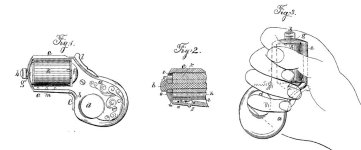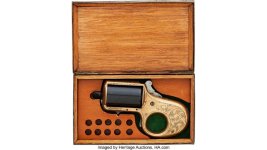Kasian
Member
- Joined
- Dec 8, 2024
- Messages
- 63
- Reaction score
- 73
Sorry if I am repeating some old post....
James Reid's "My Friend" Knuckle Dusters:
This … five shot repeater, with butt shaped in the form of a hand knuckle … gave the [riverboat] gambler fire power but also a hand weapon of defense."
Irish-born James Reid, an émigré from Glasgow, Scotland, landed on American shores in 1857 with his young family in tow. He didn't arrive empty-handed; he had cash in his pocket and was an experienced machinist. First settling in New Jersey, the Reids soon moved to New York City. Somehow this Protestant Irishman foresaw a demand for pocket pistols. Did he see urban New Jersey or New York as so dangerous that they offered a market for his pistols? It was while living in New York City that Reid began his gun manufacturing business.
In the 1863 New York City directory, he was recorded as residing at 171 East 26th St. with "pistolmaker" listed as his occupation. According to Taylor G. Bowen's work, James Reid and his Catskill Knuckledusters, it was during this time that Reid began making his first guns. According to Gluckman and Satterlee's American Gun Makers, William Irving, also of New York City, manufactured Reid's Knuckle Dusters, but this ceased after 1863 due to the infringement of the Rollin White Patent that was owned by his much larger competitor, Smith & Wesson. It also appears that Reid may have produced firearms for James P. Fitch, another gunmaker at this time.
In December 1865, Reid was granted a patent for an "Improvement in Revolving Fire Arms." This was based, to a degree, on Reid's contention that, "My invention is applied to a series of short barrels mounted on a center-pin ... I form the handle with a bow behind the trigger-shield so that the implement may be held securely in the hand and used for protection after the barrels may have been discharged, or before it becomes necessary to use them."
The mechanism involves a cylinder that rotates on a center pin. When loading the Knuckle Duster, that center pin is detached from the frame. This permits one to remove the cylinder to load it. There was one important design flaw; the cylinder pin had right-hand threads. As a result, the pin loosened as the cylinder rotated to the right.
Reid rectified this by switching the cylinder pin to revolve to the left. A safety mechanism locked the gun, so its firing pin was always secured between two chambers. The second design feature, referred to earlier, connected the spur trigger to the bottom of the grip to form a metal bow. This was a unique design for its time.
With this knuckle bow, one could hit an opponent without injuring one's hand. Reid created this dual-purpose self-defense tool with a strategy in mind, believing that not every altercation should end in a fatality. In his own words, "Never shoot a man if you can knock him down."
On versions of this revolver and more info and pictures: James Reid's "My Friend" Knuckle Dusters | An Official Journal Of The NRA
James Reid's "My Friend" Knuckle Dusters:
This … five shot repeater, with butt shaped in the form of a hand knuckle … gave the [riverboat] gambler fire power but also a hand weapon of defense."
Irish-born James Reid, an émigré from Glasgow, Scotland, landed on American shores in 1857 with his young family in tow. He didn't arrive empty-handed; he had cash in his pocket and was an experienced machinist. First settling in New Jersey, the Reids soon moved to New York City. Somehow this Protestant Irishman foresaw a demand for pocket pistols. Did he see urban New Jersey or New York as so dangerous that they offered a market for his pistols? It was while living in New York City that Reid began his gun manufacturing business.
In the 1863 New York City directory, he was recorded as residing at 171 East 26th St. with "pistolmaker" listed as his occupation. According to Taylor G. Bowen's work, James Reid and his Catskill Knuckledusters, it was during this time that Reid began making his first guns. According to Gluckman and Satterlee's American Gun Makers, William Irving, also of New York City, manufactured Reid's Knuckle Dusters, but this ceased after 1863 due to the infringement of the Rollin White Patent that was owned by his much larger competitor, Smith & Wesson. It also appears that Reid may have produced firearms for James P. Fitch, another gunmaker at this time.
In December 1865, Reid was granted a patent for an "Improvement in Revolving Fire Arms." This was based, to a degree, on Reid's contention that, "My invention is applied to a series of short barrels mounted on a center-pin ... I form the handle with a bow behind the trigger-shield so that the implement may be held securely in the hand and used for protection after the barrels may have been discharged, or before it becomes necessary to use them."
The mechanism involves a cylinder that rotates on a center pin. When loading the Knuckle Duster, that center pin is detached from the frame. This permits one to remove the cylinder to load it. There was one important design flaw; the cylinder pin had right-hand threads. As a result, the pin loosened as the cylinder rotated to the right.
Reid rectified this by switching the cylinder pin to revolve to the left. A safety mechanism locked the gun, so its firing pin was always secured between two chambers. The second design feature, referred to earlier, connected the spur trigger to the bottom of the grip to form a metal bow. This was a unique design for its time.
With this knuckle bow, one could hit an opponent without injuring one's hand. Reid created this dual-purpose self-defense tool with a strategy in mind, believing that not every altercation should end in a fatality. In his own words, "Never shoot a man if you can knock him down."
On versions of this revolver and more info and pictures: James Reid's "My Friend" Knuckle Dusters | An Official Journal Of The NRA




